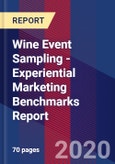The Wine Event Sampling - Experiential Marketing Benchmarks Report details benchmarks about consumer reach, impact, and return-on-investment for experiential marketing activations for brands in the wine event sampling industry. This report represents activations where bottled wine brands were sampled at on- and/ or off-premise activations through an estimated 2,149,337 samples.
The wine sampling industry is an established and growing business sector for alcoholic beverage producers. Throughout the past two decades, the U.S. wine industry has nearly doubled from around $30 billion in 2002 to more than $60 billion today. Successful wine producers seek to influence their customers through various wine sampling, or wine tasting, events. As consumers sample and become fans of certain wines, they will be more likely to pay at premium prices. With a vast variety of wine flavors and types, it is often difficult for producers to predict their customer's preferences. This is where wine event sampling is particularly useful.
The data used to develop benchmarks in this report were gathered from 29,555 activation days combined with 43,470 consumer exit interviews where wine brands were sampled by consumers. An estimated 10,246,434 attendees were at the event venues presented in this report. Reporting insights include reach efficiency, reach quality, brand awareness, marketing impact, and return-on-investment. Several demographic segments were used to outline each of the reporting insights.
The wine sampling industry is an established and growing business sector for alcoholic beverage producers. Throughout the past two decades, the U.S. wine industry has nearly doubled from around $30 billion in 2002 to more than $60 billion today. Successful wine producers seek to influence their customers through various wine sampling, or wine tasting, events. As consumers sample and become fans of certain wines, they will be more likely to pay at premium prices. With a vast variety of wine flavors and types, it is often difficult for producers to predict their customer's preferences. This is where wine event sampling is particularly useful.
The data used to develop benchmarks in this report were gathered from 29,555 activation days combined with 43,470 consumer exit interviews where wine brands were sampled by consumers. An estimated 10,246,434 attendees were at the event venues presented in this report. Reporting insights include reach efficiency, reach quality, brand awareness, marketing impact, and return-on-investment. Several demographic segments were used to outline each of the reporting insights.
Table of Contents
1. Index of Tables
2. Introduction to This Report
3. Using Benchmarks to Build Best-in-Class Experiential Marketing Campaigns
4. Experiential Measurement Best Practices - The Theory
5. Metrics And Definitions For This Report
6. Event Marketing Reach
7. Event Marketing Impact
8. Event Marketing Return-on-Investment
9. Appendix








